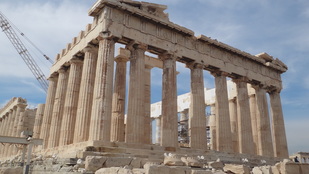
The first part of our trip in Athens was obviously marked by riots, which severely limited our ability to move around the city--public transportation systems were either completely shut down or had flaky schedules, shops were closed, and parts of the city were just too risky.
But, after a few days, we were able to see some of Athens' most famous sites.
Of course, we went to the Acropolis. The Acropolis is the highest point in the city (490 ft above sea level)--a flat-topped rock that towers over Athens, and on which the Parthenon rests. The earliest settlement on the Acropolis dates back to 6th millenium BC and then became a sacred temple to Athena in 6th century BC. We learned at the nearby Acropolis Museum (a must visit) afterwards many interesting things, but here's 3 of them:
1. The Acropolis has undergone several transformations and devastation (fires, wars, etc). Incredible, lavish temples would be built for a god (usually Athena) or a king, they would be plundered or destroyed, and then rebuilt or reworked. It was a cycle over and over. So many precious things ruined by greed, war, or simply time.
2. Like we'd seen at other historical monuments, key statues on the Acropolis were replicas. The actual ones are preserved and restored inside the museum.
3. The British are thieves. Aside from the Parthenon perched on top of the Acropolis, there is also the Erectheion (used to be the Old Temple of Athena). On it stand six draped female figures (caryatids). Well, there were six. But, Lord Elgin stole one of them late one night, and then it was later sold to the British Museum. The British Museum still won't give the 6th caryatid back to the Greeks, despite their constant requests. We saw similar acts of "finders, keepers" attitudes in other parts of our travels.
Another word to the wise, the Parthenon is usually under construction. I know you'll see pictures of the Parthenon with no cranes, but that's probably not what you'll see. This was my 2nd time at the Acropolis in 7 years, and it's still under construction.
Although the Parthenon is certainly the most famous site, the Acropolis also has several other monuments and artifacts near it. My favorite was the Theatre of Dionysus.
But, after a few days, we were able to see some of Athens' most famous sites.
Of course, we went to the Acropolis. The Acropolis is the highest point in the city (490 ft above sea level)--a flat-topped rock that towers over Athens, and on which the Parthenon rests. The earliest settlement on the Acropolis dates back to 6th millenium BC and then became a sacred temple to Athena in 6th century BC. We learned at the nearby Acropolis Museum (a must visit) afterwards many interesting things, but here's 3 of them:
1. The Acropolis has undergone several transformations and devastation (fires, wars, etc). Incredible, lavish temples would be built for a god (usually Athena) or a king, they would be plundered or destroyed, and then rebuilt or reworked. It was a cycle over and over. So many precious things ruined by greed, war, or simply time.
2. Like we'd seen at other historical monuments, key statues on the Acropolis were replicas. The actual ones are preserved and restored inside the museum.
3. The British are thieves. Aside from the Parthenon perched on top of the Acropolis, there is also the Erectheion (used to be the Old Temple of Athena). On it stand six draped female figures (caryatids). Well, there were six. But, Lord Elgin stole one of them late one night, and then it was later sold to the British Museum. The British Museum still won't give the 6th caryatid back to the Greeks, despite their constant requests. We saw similar acts of "finders, keepers" attitudes in other parts of our travels.
Another word to the wise, the Parthenon is usually under construction. I know you'll see pictures of the Parthenon with no cranes, but that's probably not what you'll see. This was my 2nd time at the Acropolis in 7 years, and it's still under construction.
Although the Parthenon is certainly the most famous site, the Acropolis also has several other monuments and artifacts near it. My favorite was the Theatre of Dionysus.
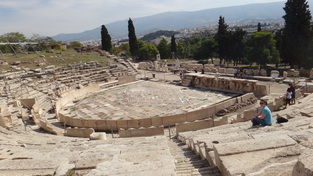
The Theatre of Dionysus, erected around 6th century BC, is probably the oldest surviving theatre anywhere. Dedicated to the God of wine and Patron of drama (Dionysus), festivals were held in this theatre, and dramatists like Sophicles and Euripedes competed with their works.
The theatre is being restored, since not much from the original theatre is remaining. It was such a cool feeling, though, to sit on the stone and just picture the dramas unfolding on that open air stage. In those days, there were only male actors allowed to perform, and some were actually killed for dramatic effect.
There is one more theatre nearby--the Odeon of Herodus Atticus. It's very well preserved (and was just restored for use during the Athens Olympics), and was built in 161 AD by a very rich man (Herodus Atticus) in memory of his wife.
Herodus Atticus also funded the Panathenaic Stadium renovation in 140 AD, where athletic games were played and the first modern Olympic Games were later held in 1896. It's one of the oldest stadiums in the world and is built entirely of white marble. Still in excellent condition, it was incredible to walk around the 50,000 seats and on the center field. Of course, we did an obligatory "race" on the field. Chris won, but let's not talk about that.
The theatre is being restored, since not much from the original theatre is remaining. It was such a cool feeling, though, to sit on the stone and just picture the dramas unfolding on that open air stage. In those days, there were only male actors allowed to perform, and some were actually killed for dramatic effect.
There is one more theatre nearby--the Odeon of Herodus Atticus. It's very well preserved (and was just restored for use during the Athens Olympics), and was built in 161 AD by a very rich man (Herodus Atticus) in memory of his wife.
Herodus Atticus also funded the Panathenaic Stadium renovation in 140 AD, where athletic games were played and the first modern Olympic Games were later held in 1896. It's one of the oldest stadiums in the world and is built entirely of white marble. Still in excellent condition, it was incredible to walk around the 50,000 seats and on the center field. Of course, we did an obligatory "race" on the field. Chris won, but let's not talk about that.
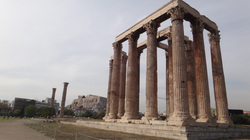
Temple of Zeus (remaining columns)
A short walking distance away from the Acropolis stands the Temple of Zeus. Some columns still remain, and they were HUGE. It's absolutely humbling to stand next to these 100ft+ columns that ancient Greeks built in ~450BC. Although it used to house a statue of Zeus, I think these remaining columns alone are incredible. One column actually tumbled down in a heavy thunderstorm almost 100 years ago...and they left it on the ground. That column survived thousands of years and wars, but a rainstorm took it down, and there it stays.
We took a little "hop on off" (what we liked to call them) train that went around to many sites on our last day. That was fun, although schedules were a little weird, and I'd recommend it to those wanting to see the popular historical sites.
Leaving Athens was hard because we really had a GREAT time, fantastic food, and a gracious host. The food was the best we had anywhere, plus we got home cooking from Ephi! :) We also had a chance to recharge and just enjoy the city at our own pace. We didn't get to the Islands this time because of the riots and budget, but we will definitely go back to Athens and see the Islands sometime soon!
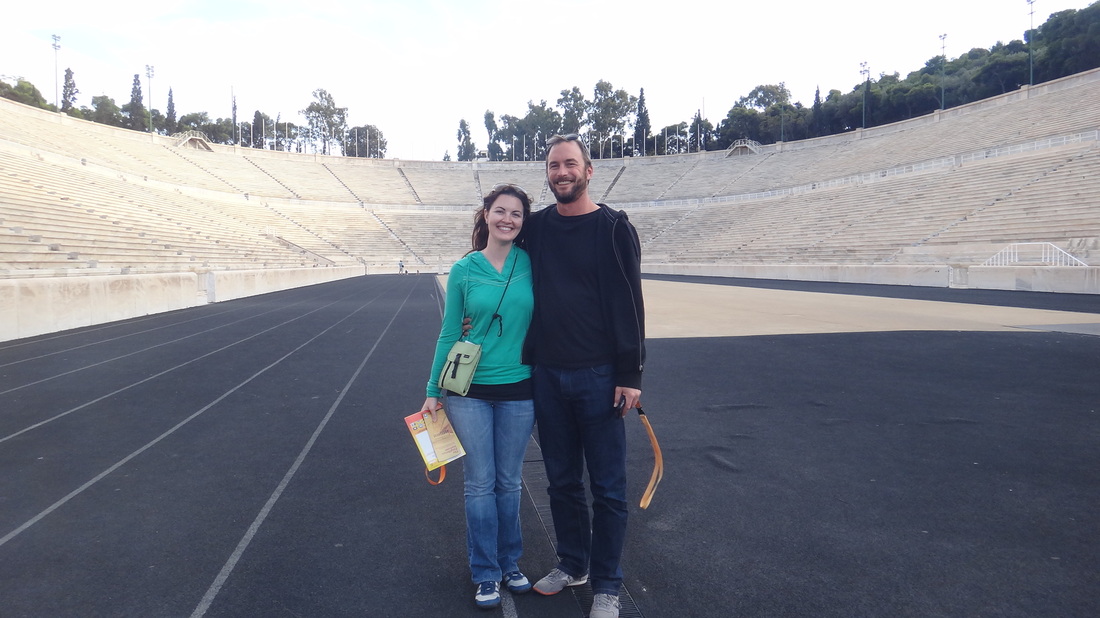
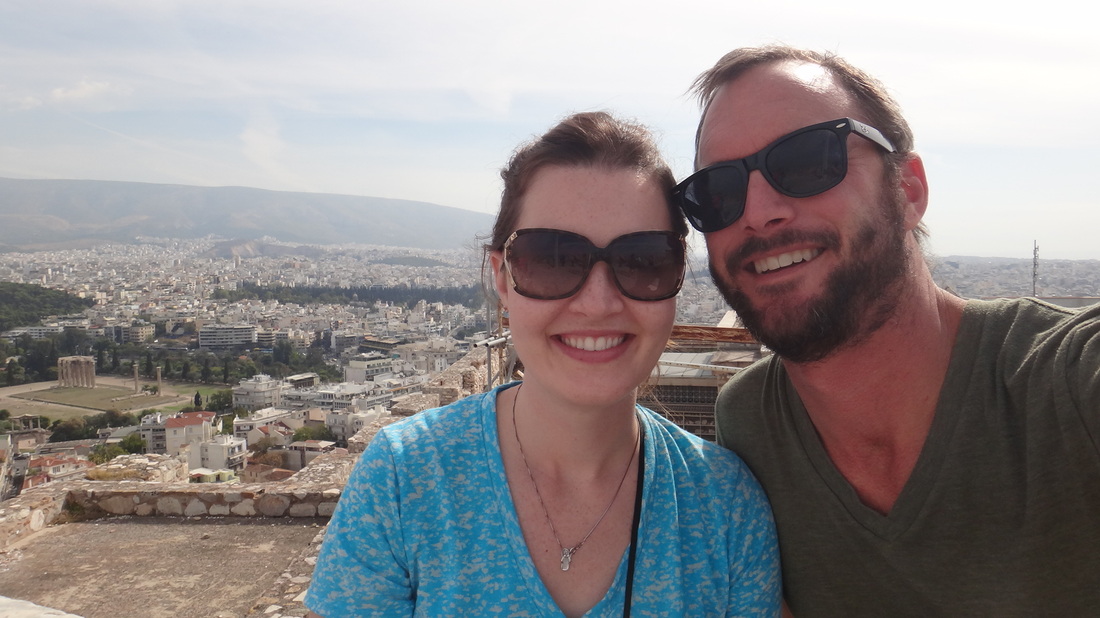

 RSS Feed
RSS Feed